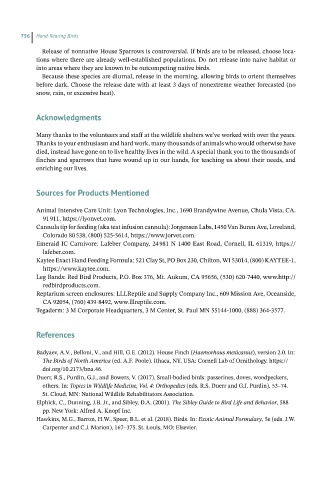Page 754 - Hand rearing birds second
P. 754
756 Hand-Rearing Birds
Release of nonnative House Sparrows is controversial. If birds are to be released, choose loca-
tions where there are already well‐established populations. Do not release into naive habitat or
into areas where they are known to be outcompeting native birds.
Because these species are diurnal, release in the morning, allowing birds to orient themselves
before dark. Choose the release date with at least 3 days of nonextreme weather forecasted (no
snow, rain, or excessive heat).
Acknowledgments
Many thanks to the volunteers and staff at the wildlife shelters we’ve worked with over the years.
Thanks to your enthusiasm and hard work, many thousands of animals who would otherwise have
died, instead have gone on to live healthy lives in the wild. A special thank you to the thousands of
finches and sparrows that have wound up in our hands, for teaching us about their needs, and
enriching our lives.
Sources for Products Mentioned
Animal Intensive Care Unit: Lyon Technologies, Inc., 1690 Brandywine Avenue, Chula Vista, CA.
91 911, https://lyonvet.com.
Cannula tip for feeding (aka teat infusion cannula): Jorgensen Labs, 1450 Van Buren Ave, Loveland,
Colorado 80 538, (800) 525‐5614, https://www.jorvet.com.
Emeraid IC Carnivore: Lafeber Company, 24 981 N 1400 East Road, Cornell, IL 61319, https://
lafeber.com.
Kaytee Exact Hand Feeding Formula: 521 Clay St, PO Box 230, Chilton, WI 53014, (800) KAYTEE‐1,
https://www.kaytee.com.
Leg Bands: Red Bird Products, P.O. Box 376, Mt. Aukum, CA 95656, (530) 620‐7440, www.http://
redbirdproducts.com.
Reptarium screen enclosures: LLLReptile and Supply Company Inc., 609 Mission Ave, Oceanside,
CA 92054, (760) 439‐8492, www.lllreptile.com.
Tegaderm: 3 M Corporate Headquarters, 3 M Center, St. Paul MN 55144‐1000, (888) 364‐3577.
References
Badyaev, A.V., Belloni, V., and Hill, G.E. (2012). House Finch (Haemorhous mexicanus), version 2.0. In:
The Birds of North America (ed. A.F. Poole). Ithaca, NY, USA: Cornell Lab of Ornithology. https://
doi.org/10.2173/bna.46.
Duerr, R.S., Purdin, G.J., and Bowers, V. (2017). Small‐bodied birds: passerines, doves, woodpeckers,
others. In: Topics in Wildlife Medicine, Vol. 4: Orthopedics (eds. R.S. Duerr and G.J. Purdin), 53–74.
St. Cloud, MN: National Wildlife Rehabilitators Association.
Elphick, C., Dunning, J.B. Jr., and Sibley, D.A. (2001). The Sibley Guide to Bird Life and Behavior, 588
pp. New York: Alfred A. Knopf Inc.
Hawkins, M.G., Barron, H.W., Speer, B.L. et al. (2018). Birds. In: Exotic Animal Formulary, 5e (eds. J.W.
Carpenter and C.J. Marion), 167–375. St. Louis, MO: Elsevier.

